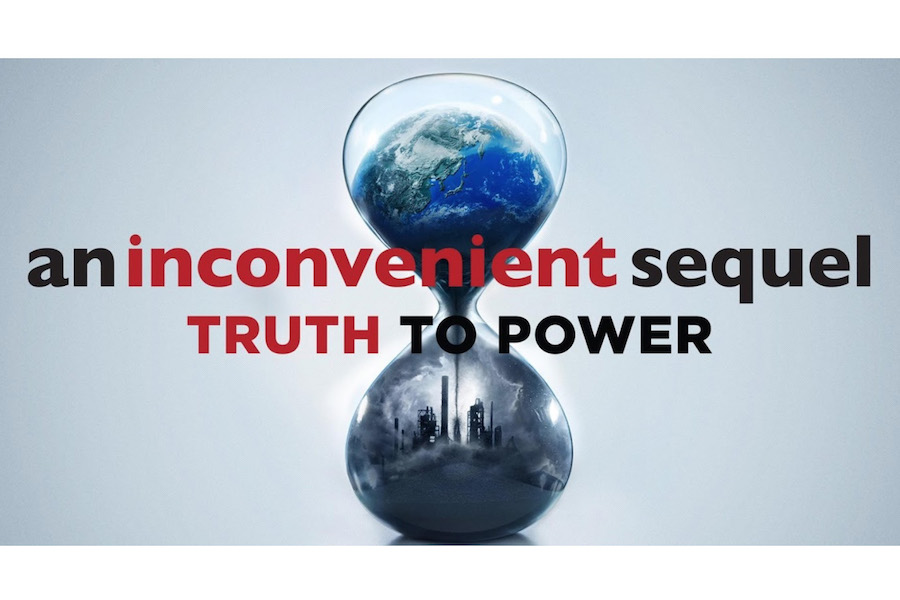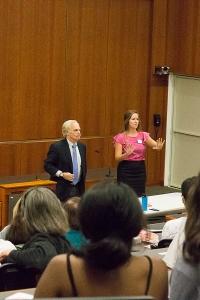
Hope and determination necessary for smart energy transformation
“An Inconvenient Sequel: Truth to Power” was screened to a full auditorium at King Hall on Oct. 26. The event was hosted by both the California Environmental Law and Policy Center and the UC Davis School of Law. The film, a sequel to 2006’s “An Inconvenient Truth,” features environmentalist and former Vice President Al Gore diving deep into the evidence of climate change and environmental destruction caused by fossil fuel energy sources.
“The impacts of climate change are all around us — as was identified in the film — in terms of more extreme storm events, wildfires, sea level rise, storm surges, Superstorm Sandy,” said Rick Frank, a professor of environmental practice and the director of the California Environmental Law and Policy Center at UC Davis. “This is just a harbinger of the new normal, and the new normal is pretty alarming.”
One of the first scenes of the film takes place in a 2007 U.S. Senate Hearing. Gore openly muses of possible methods of reaching out to people like Oklahoma Senator James Inhofe, who seem to ignore accumulated scientific evidence.
“There are very few elected leaders in our national government who have any kind of science background,” Frank said. “What they get, they have to get by osmosis, or from journalists, or other sources.”
Gore lamented how fossil fuel industries blocked the creation and adoption of solar and wind energy systems which could revolutionize transportation systems and energy consumption methods around the world. New York Attorney General Eric Schneiderman discussed an ongoing lawsuit against petroleum companies accused of lying to their stockholders and the general public about the harmful effects of oil and gas pollution.

“Exxon Mobil, for many years, it’s been documented they had internal science that was informing of the reality of climate change at the same time they were buying expensive, full-page ads in the New York Times, the Washington Post and other major newspapers casting doubt on it and attempting to discredit the whole idea of climate change and climate science,” Frank said.
Many devastating weather systems were featured in the film. Hurricanes and typhoons derive their strength from water vapor in the air and warm ocean waters, both of which have increased in the industrial era. Typhoon Haiyan devastated the Philippines in November 2013 partly because ocean waters were about 10 degrees Fahrenheit warmer than usual at that time of year.
“There was a point where he talked about how the poorest people are affected the most by these events,” said Madison Farricker, a fifth-year environmental policy major. “That’s so true, and they have the fewest resources to get through those times, as well. Definitely motivates me to continue on my [career] path.”
Challenges lie in both adjusting the energy and transportation infrastructure already in place and shoring up defenses against extreme weather events.
“I think the State of California has pioneered a lot of important policies, in terms of both mitigating greenhouse gas emissions and adapting to the unavoidable consequences of climate change,” Frank said.
Davis has been trending in a positive direction. Most homes and apartment complexes are equipped with small containers for composting food materials. The CoHo uses composted materials for utensils, plates, and take-out bags. Recycling stations around the university campus help dispose of electronic waste. Many residents utilize methods of transportation, such as bicycling or walking, which eliminate emissions from vehicles. The UC system has launched the #MyLastTrash campaign, which is an initiative to have zero waste going to landfills by 2020, with 69 percent of the waste already diverted from landfills.
Gore helped create the Climate Reality Leadership Corps to train hundreds of hopeful activists around the world to contribute innovative solutions to solve the energy crisis. One tactic is to convince friends and family of the reality and gravity of the climate crisis.
“I definitely think [the film will] make me more conscious of the little things that I do in my daily life,” said Alisha Hacker, a first-year political science major. “Like making sure I recycle everything that I can, making sure that if I can carpool, I’m trying to, or trying to bike as much as I can.”
Cities around the United States have been adopting plans to use 100 percent of their energy from renewable sources such as wind and solar energy. One featured city is Georgetown, Texas, which the town’s mayor calls “the reddest city in the reddest county in Texas.” Georgetown is located on the outskirts of Austin, less than 200 miles from Houston, a huge oil refinery hub. Gore spent some time with the Georgetown mayor, a conservative Republican, who explained his rationale for spearheading the city’s renewable energy project: “The less stuff you put in the air, the better it is.”
Gore insisted that people around the world continue to advocate for an energy system which takes advantage of wind and solar energies instead of oil and gasoline. Nations such as Germany, Chile and Costa Rica have been pursuing solar, wind and geothermal energy technologies to support their infrastructure.
“One thing I’m comforted by is that, in a federal administration that is, at best, disinterested in climate change, and at worst, overtly hostile to climate change reform, that the state of California has stepped up and has made clear they are at full speed ahead in terms of state policy in this area,” Frank said. “I find that very encouraging. “
Written By: George Ugartemendia — science@theaggie.org


